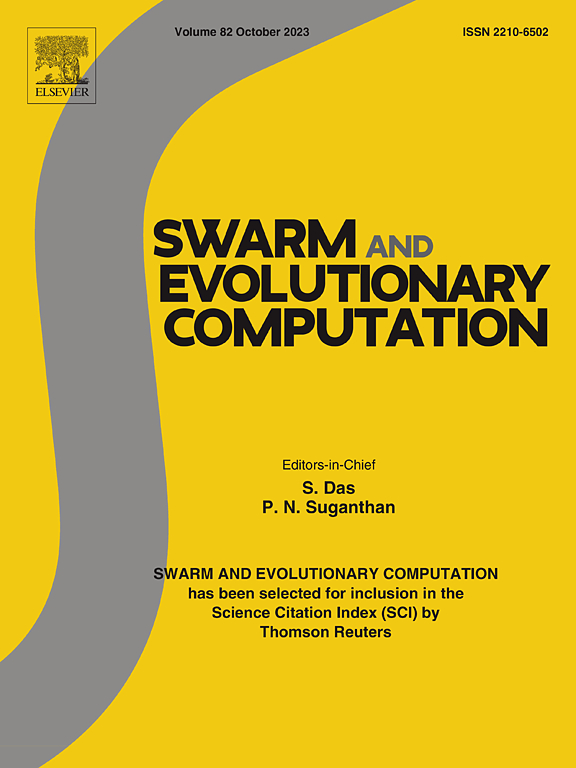基于基因型偏好的多种群竞争进化算法多模态多目标优化
IF 8.2
1区 计算机科学
Q1 COMPUTER SCIENCE, ARTIFICIAL INTELLIGENCE
引用次数: 0
摘要
现有的许多多模态多目标进化算法(MMOEAs)在解决多模态多目标优化问题(MMOPs)时表现不佳,这主要是由于环境选择的遗传多样性有限。本文提出了一种基于基因型偏好的多种群竞争进化算法(MPCEA-GP)来解决多目标优化问题。首先,我们提出了一种基于基因型偏好的种群选择策略,以保持种群的遗传多样性。该策略利用光谱半径来评估种群的整体收敛质量,而不是单独评估每个个体,并倾向于选择光谱半径最小的种群,从而保留最优个体和次优个体的基因型。其次,为了应对进化过程中遗传多样性减少的挑战,我们将具有大量遗传多样性的历史生存种群纳入亲代和子代的竞争中,并优先选择基因型差异显著的个体重组为一个新种群。通过合并两个被选中的种群,构建一个具有足够遗传多样性的联合种群。最后,设计出一种基于基因型-表型的适配性标准来评估个体的适配性。该标准不仅利用帕累托优势原理对基因型进行比较,还同时考虑了基因型和表型的多样性,从而帮助种群更精确地识别出具有良好趋同性和多样性的个体。实证结果表明,在 40 个选定的基准函数和两个复杂的实际应用中,MPCEA-GP 优于最先进的 MMOEA。本文章由计算机程序翻译,如有差异,请以英文原文为准。
A multi-population competitive evolutionary algorithm based on genotype preference for multimodal multi-objective optimization
Many existing multimodal multi-objective evolutionary algorithms (MMOEAs) exhibit poor performance in addressing multimodal multi-objective optimization problems (MMOPs), mainly due to limited genetic diversity in environmental selection. In this paper, we propose a multi-population competitive evolutionary algorithm based on genotype preference (MPCEA-GP) to solve MMOPs. Firstly, we propose a population selection strategy based on genotype preference to maintain the genetic diversity of the population. This strategy utilizes the spectral radius to assess the overall convergence quality of the population, rather than evaluating each individual separately, and favors selecting the population with the minimum spectral radius, thereby preserving the genotypes of both optimal and suboptimal individuals. Secondly, to address the challenge of diminished genetic diversity during the evolutionary process, we incorporate historical survival population with substantial genetic diversity into the competition between parent and offspring, and preferentially select individuals with significant genotype differences to recombine into a new population. By merging two selected populations, a joint population with sufficient genetic diversity is constructed. Finally, a genotype-phenotype-based fitness criterion is devised to evaluate the fitness of individuals. This criterion not only compares genotypes using the Pareto dominance principle but also concurrently considers both genotype and phenotype diversity, aiding the population in more precisely identifying individuals with both good convergence and diversity. Empirical results show that MPCEA-GP outperforms state-of-the-art MMOEAs for 40 chosen benchmark functions and two complex real-world applications.
求助全文
通过发布文献求助,成功后即可免费获取论文全文。
去求助
来源期刊

Swarm and Evolutionary Computation
COMPUTER SCIENCE, ARTIFICIAL INTELLIGENCEC-COMPUTER SCIENCE, THEORY & METHODS
CiteScore
16.00
自引率
12.00%
发文量
169
期刊介绍:
Swarm and Evolutionary Computation is a pioneering peer-reviewed journal focused on the latest research and advancements in nature-inspired intelligent computation using swarm and evolutionary algorithms. It covers theoretical, experimental, and practical aspects of these paradigms and their hybrids, promoting interdisciplinary research. The journal prioritizes the publication of high-quality, original articles that push the boundaries of evolutionary computation and swarm intelligence. Additionally, it welcomes survey papers on current topics and novel applications. Topics of interest include but are not limited to: Genetic Algorithms, and Genetic Programming, Evolution Strategies, and Evolutionary Programming, Differential Evolution, Artificial Immune Systems, Particle Swarms, Ant Colony, Bacterial Foraging, Artificial Bees, Fireflies Algorithm, Harmony Search, Artificial Life, Digital Organisms, Estimation of Distribution Algorithms, Stochastic Diffusion Search, Quantum Computing, Nano Computing, Membrane Computing, Human-centric Computing, Hybridization of Algorithms, Memetic Computing, Autonomic Computing, Self-organizing systems, Combinatorial, Discrete, Binary, Constrained, Multi-objective, Multi-modal, Dynamic, and Large-scale Optimization.
 求助内容:
求助内容: 应助结果提醒方式:
应助结果提醒方式:


